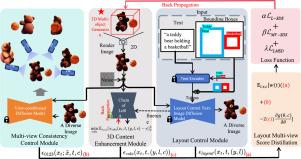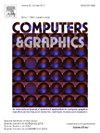Controllable text-to-3D multi-object generation via integrating layout and multiview patterns
IF 2.8
4区 计算机科学
Q2 COMPUTER SCIENCE, SOFTWARE ENGINEERING
引用次数: 0
Abstract
The controllability of 3D object generation methods is achieved through textual input. Existing text-to-3D object generation methods focus primarily on generating a single object based on a single object description. However, these methods often face challenges in producing results that accurately correspond to our desired positions when the input text involves multiple objects. To address the issue of controllability in the generation of multiple objects, this paper introduces COMOGen, a COntrollable text-to-3D Multi-Object Generation framework. COMOGen enables the simultaneous generation of multiple 3D objects by distilling layout and multiview prior knowledge. The framework consists of three modules: the layout control module, the multiview consistency control module, and the 3D content enhancement module. Moreover, to integrate these three modules as an integral framework, we propose Layout Multiview Score Distillation, which unifies two prior knowledge and further enhances the diversity and quality of generated 3D content. Comprehensive experiments demonstrate the effectiveness of our approach compared to state-of-the-art methods. This represents a significant step forward to enable more controlled and versatile text-based 3D content generation.

通过集成布局和多视图模式,可控文本到3d的多对象生成
通过文本输入实现了三维对象生成方法的可控性。现有的文本到3d对象生成方法主要侧重于基于单个对象描述生成单个对象。然而,当输入文本涉及多个对象时,这些方法在生成准确对应于我们期望位置的结果时经常面临挑战。为了解决多目标生成的可控性问题,本文引入了可控文本到三维多目标生成框架COMOGen。通过提取布局和多视图先验知识,COMOGen可以同时生成多个3D对象。该框架由三个模块组成:布局控制模块、多视图一致性控制模块和3D内容增强模块。此外,为了将这三个模块整合为一个整体框架,我们提出了Layout Multiview Score Distillation,该方法将两个先验知识结合起来,进一步提高了生成的3D内容的多样性和质量。综合实验表明,与最先进的方法相比,我们的方法是有效的。这代表了一个重要的一步,使更多的控制和通用的基于文本的3D内容生成。
本文章由计算机程序翻译,如有差异,请以英文原文为准。
求助全文
约1分钟内获得全文
求助全文
来源期刊

Computers & Graphics-Uk
工程技术-计算机:软件工程
CiteScore
5.30
自引率
12.00%
发文量
173
审稿时长
38 days
期刊介绍:
Computers & Graphics is dedicated to disseminate information on research and applications of computer graphics (CG) techniques. The journal encourages articles on:
1. Research and applications of interactive computer graphics. We are particularly interested in novel interaction techniques and applications of CG to problem domains.
2. State-of-the-art papers on late-breaking, cutting-edge research on CG.
3. Information on innovative uses of graphics principles and technologies.
4. Tutorial papers on both teaching CG principles and innovative uses of CG in education.
 求助内容:
求助内容: 应助结果提醒方式:
应助结果提醒方式:


